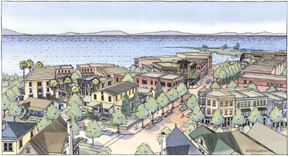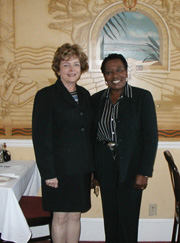
HERCULES:
FROM DYNAMITE TO AN EXPLOSION OF NEW SHORELINE
HOMES
 |
| Hercules
Town Center, as viewed from above |
For many years, Hercules was
organized around one of the world’s largest dynamite manufacturing
plants. In the early 1970’s, the Hercules Powder Company plant
closed, leaving about 20,000 residents living in the eight square
miles of Hercules and lingering remnants of dynamite manufacture.
Due to a series of set-backs that drained the City’s budget,
including the downturn economy that affected every community, the
very survival of Hercules was threatened. But, an ambitious plan
launched by the City staff promises to make Hercules into a town
with broad-based appeal, not just to Hercules residents, but to Bay
Area residents.
Homes Selling Like Hot Cakes
Single-family homes in this
waterfront setting begin selling at $450,000 for a modest 1500
square foot home and rise to as high as $650,000. Despite these
prices, the homes are being snapped up like hotcakes, with a
majority of the planned homes already pre-sold! In addition to
single-family homes, plans call for hundreds of live-work units and
apartments and at least a dozen affordable townhouses. All told, the
new town will offer approximately 1100 residential units.
Located across 167 acres, this
impressive project is under construction. The homes that are
completed follow an old style Victorian design, complete with
porches, big windows, and lots of charm.
 |
| A
model home from Hercules |
New Urbanism
Using a set of principles, which
call for a "New Urbanism," citizens of Hercules drew
pictures and provided comments that led to the final plan. The
resulting development would adhere to the basics of walkable
streets, real civic spaces, minimal evidence of automobiles, vibrant
retail spaces, diverse commercial use, and a wide selection of
housing options.
Bixby Company was chosen from
among about 20 bidders to develop the town. According to John Bauke,
Bixby Company’s Project Manager, his company’s strength was a
good match for the city. Specifically, Bixby specializes in
smart-growth, which includes working with underutilized property. In
this case, the land parcel, a Brownfield site, had undergone a
Superfund clean-up that brought it up to residential standards.
 |
| WTA
Board President Charlene Haught Johnson visiting Richmond’s
Mayor Irma Anderson |
"New urbanism requires
greater time, effort and money. But, the resulting product is worth
more and the public are willing to pay more for a quality
product," Mr. Bauke explained. "In fact," he said,
"profits from this project are far exceeding
expectations."
 |
| Hercules
live-work near train station |
On a fast track to final
completion by 2007, the town’s vision is quickly taking shape in
the form of a new mixed-use district. The site is currently abuzz
with bulldozers and planners toting architectural renderings.
According to the City Manager, Mike Sakamoto, those bulldozers have
been hard at work clearing the land and creating, in various phases,
the four distinct subdivisions that comprise this
pedestrian-friendly, commercial Town Center. Mr. Sakamoto looks
forward to living in his own house that is under construction on the
site. He said, "This is an exciting time to be living in
Hercules. "
Vice-Mayor Balico described the
process of designing the Historic Town Center of the City of
Hercules as a planning process that benefited from innovative and
extensive public input. "Through a series of public outreach
meetings, the people of Hercules helped plan a town that looks like
something they’d want to live in," he said.
 |
| Hercules
mixed-use building with cafe |
Water Transit-Oriented Development
(WaTOD)
The new Hercules Town Center is
located on the Eastern shore of the San Pablo Bay. Like many
waterfront communities, such as Sausalito, where the town center is
located right at the shoreline, Hercules is ideally suited for water
transit-oriented development. Of Bay Area ferry terminals, Sausalito
boasts of the highest number of riders who walk to the ferry
terminal. Similar to Jack London Square’s layout in Oakland,
railroad tracks in Hercules separate the developing Town Center and
anticipated parking garage from the assumed location of a ferry
terminal.
A new Amtrak station along the
shoreline of Hercules is slated to open in 2005, adding to the City’s
transit-oriented possibilities. Hercules planners envision a
pedestrian bridge crossing the tracks for easy access to a potential
ferry terminal. Currently the only other transit serving Hercules is
WestCat, a bus service that transports passengers as far as Crockett
on one side and the Del Norte BART on the other side of Hercules.
Some of the funding for the ferry terminal may
come out of sales tax reauthorizations going to the ballot in 2004
for a funding stream to begin in 2007. The Water Transit Authority
has predicted that initial ferry service to Hercules could begin in
2013, but, depending on a variety of factors, it could happen even
sooner.